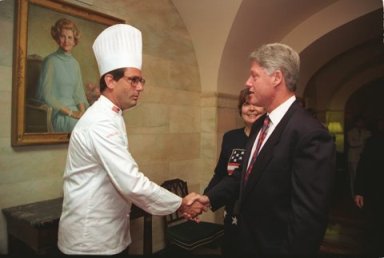Chefs Speak Out: Walter Scheib, an American Chef at the White House
23 November 2009By Lynn Schwartz
 Veteran chef to two administrations, Scheib believes Americans’ biggest culinary challenge is to figure out how to meet increasing demand for fresh, local and artisanal food products.
Veteran chef to two administrations, Scheib believes Americans’ biggest culinary challenge is to figure out how to meet increasing demand for fresh, local and artisanal food products.
Walter Scheib is modest about how he found himself “inexplicably” at the White House, chef to America’s chief executive and the First Family. But his arrival in April 1994 can be explained as a clear case of opportunity meets preparedness.
First Lady Hillary Clinton provided the opportunity, and Scheib was prepared with a strong and varied culinary background. Scheib, cooking before the age of 10, attended The Culinary Institute of America and served as executive chef at the Boca Raton Resort and Club and The Greenbrier. Scheib understood the business side of the industry and had experience overseeing a large brigade of chefs and stewards. Hillary Clinton thought it important to showcase the best of American cuisine and was impressed by Scheib’s work at The Greenbrier and his emphasis on American bounty. For the White House, this culinary transition was historic. Previously, White House cuisine was strictly Continental, and such a significant change had not been made since Jackie Kennedy introduced haute cuisine.
White House Dish
For the next 11 years, working for both the Clinton and Bush families, Scheib prepared everything from simple family meals to elaborate and formal state dinners. Guests included Nelson Mandela, Emperor Akihito, Boris Yeltsin, Lady Diana Spencer, Tony Blair and numerous other political figures and celebrities.
Scheib, unlike many chefs in less-distinguished positions, did not spend time courting fans or creating a celebrity lifestyle. “I had the ability to check my ego at the door,” he says. “You are in a home, not a restaurant or hotel. The position is about pleasing the First Lady.” Scheib worked long hours and then went home; discretion required that he not discuss his work.
Today, Scheib has reinvented himself by forming his own company, The American Chef, through which he shares his knowledge and the development of American cuisine at the White House. After so many years without a social life, Scheib finds meeting Americans around the country a cathartic experience. The American Chef offers catering, corporate team building (using group cooking as a method of team bonding) and consulting. Most events involve a food component accompanied with conversation about the White House and an insider’s anecdotes.
Scheib says audiences often assume that Democrats must eat one way and Republicans another. “Food at the White House didn’t delineate on party lines,” says Scheib, “but rather on gender lines. Mrs. Clinton favored nutritional foods and Mrs. Bush was adamant about organic foods. Both presidents felt that if cheese was melted on it, we were talking great dining.” Scheib’s book, White House Chef: Eleven Years, Two Presidents, One Kitchen (John Wiley & Sons), was released in January 2007 and elaborates on recipes developed there and his experiences with the two families.
An American Chef
As Scheib reflects on the future of American cuisine, he is baffled by how the culinary world is depicted on television, noting that many culinary television shows are about bizarre personalities and only play at cooking professionally. He cites a show where a cake is built in one place and then transported to another location. “Why would you do that?” Scheib says. “Viewers seem to want to see something horrific. They want to see the cake collapse. I don’t know what this has to do with the hospitality business.” He recalls another show, which revolves around the ability to eat the biggest hamburger. “It’s a circus sideshow.”
Eventually, Scheib was coaxed to appear on Iron Chef in 2006, which he calls “professional wrestling for the culinary set.” He battled Cat Cora and won. Scheib approached the task seriously and with the utmost professionalism. “Our team practiced for the better part of a month. If you are going to present yourself on a national stage, you want to present well.”
As more Americans embrace fresh, local and artisanal food products, Scheib believes that our biggest culinary challenge is to figure out how to meet that increasing demand. “Organic food is expensive, which makes it elitist,” he says. “How are we going to get the great monolith farms to meet the needs of all people who want to eat more quality, flavorful foods?” Scheib does not have a clear answer, but stresses that we should all be focused on finding a solution.
Scheib does know this: If you want to be a chef, you must conduct yourself as a professional, you must have a palate for cooking and you must have the desire to make people happy. “At the highest level, you have to figure out how to make the meal memorable because chefs sell memories,” he says. “To do this, you don’t need to serve complicated fare. Don’t screw up the flavors. Let a beautiful peach be a beautiful peach. Your cuisine doesn’t need to be highly technical; it has to taste good. A memorable dish needs to have soul. It has to dance.”
Lynn Schwartz is a writer and former New York City restaurateur. She is currently the show manager for The Food & Wine Festival at National Harbor. She is based in Maryland.
Additional Info
- CAFÉ Talks Podcast Lesson Plan: 8
